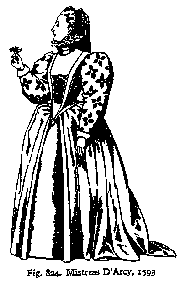

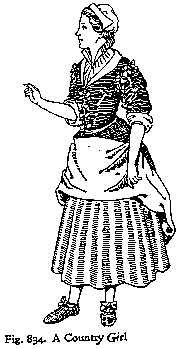 Women's clothing
begins with their underwear, which is a chemise or smock. The chemise is
nightgown-like undergarment, usually of white linen. It may show slightly
above the bodice or through the sleeves, but it is underclothing and therefore
normally hidden.. It is typically worn with a partlet -- a garment gathered
to a neckband that filled in the part of a womanís chest above the bodice.
The comon style of chemise withi drawstring neck and wrists used in Renn
Faires and most SCA activities doesn't resemble anything documented in
our time period. Italian women used a smocked style of chemise, where the
gament is gathered to a solid band, but the average woman's chemise was
very ancient in design, being made tunic-like of square, ungathered pieces.Working
women are often depicted without oversleeves or jacket, with their
chemise sleeves rolled up. For upper class women, this chemise may be of
very fine linen, and beautifully worked with embroidery that no one but
the lady, her maids, and her bedfellows ever saw.
Women's clothing
begins with their underwear, which is a chemise or smock. The chemise is
nightgown-like undergarment, usually of white linen. It may show slightly
above the bodice or through the sleeves, but it is underclothing and therefore
normally hidden.. It is typically worn with a partlet -- a garment gathered
to a neckband that filled in the part of a womanís chest above the bodice.
The comon style of chemise withi drawstring neck and wrists used in Renn
Faires and most SCA activities doesn't resemble anything documented in
our time period. Italian women used a smocked style of chemise, where the
gament is gathered to a solid band, but the average woman's chemise was
very ancient in design, being made tunic-like of square, ungathered pieces.Working
women are often depicted without oversleeves or jacket, with their
chemise sleeves rolled up. For upper class women, this chemise may be of
very fine linen, and beautifully worked with embroidery that no one but
the lady, her maids, and her bedfellows ever saw.
What happens after the chemise is a question of social class. For lower class women, the next garment may be a kirtle, a one-piece, sleeveless dress, and over this a gown or overdress, which has a bodice attached to a skirt. The gown opens up the front and is laced together. Sleeves may then be attached by pins (even the poorest women would be expected to have a little "pin money" for those so-necessary pins to keep her clothes together.). The Flemish Working Woman's outfit described by Drea Leed gives excellent instruction on how to make such an ensemble (http://www.dnaco.net/~aleed/corsets/lowerclass/makeflem.html). Although this is a style of the 1560s and 1570s, lower class people's clothing changed much more slowly than upper class fashion.
Over her chemise an upper class woman would probably be wearing a "pair of bodies" (corset) and a variable number of petticoats. The corset is boned in order to give the proper flat-chested, long-waisted look without wrinkles. The boning was done with caning or rushes (modern substitutes are of plastic or metal). Over the corset and petticoats and upper class woman would wear a gown. This is one piece, with skirts sewn to the bodice, as for the peasant overdress, but it does not usually lace up the front. Instead, it is more likely to fasten almost invisibly up the back side. The bodice has "princess seams" shaping its back, and the opening is often along one of these seams. It may be open down the front of the skirt to show petticoats or a special "forepart" underneath.
. 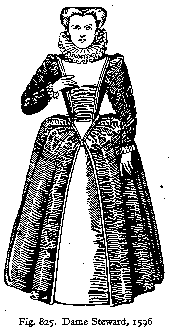
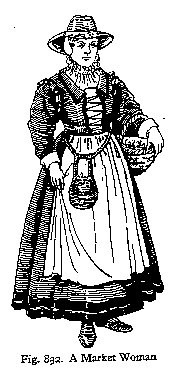 The skirts of
gowns are very full, with multiple petticoats underneath and often padded
out at the hips with a bum roll. The gown may also be hiked up and tucked
in the waist to show the petticoats. Working women wore their skirts above
their ankles, and often as high as mid-calf. They couldn't afford to be
tripping on them around the hearth!
The skirts of
gowns are very full, with multiple petticoats underneath and often padded
out at the hips with a bum roll. The gown may also be hiked up and tucked
in the waist to show the petticoats. Working women wore their skirts above
their ankles, and often as high as mid-calf. They couldn't afford to be
tripping on them around the hearth!
The market girl at the bottom of this page and has a separate bodice and petticoat and is probably not wearing a kirtle. She is wearing the cut of the 1590s, with a pronounced pointy waist, wider sleeves, and wider collar on the partlet. Her bodice must be boned in order to hold this shape. Her clothing resembles the under-layers of an upper-class woman's wardrobe.
The 1590s saw the arrival of the drum farthingale for upper class women, which looks like a platter around the womanís hips, with the skirt falling straight to the floor from the edge of it. Often a flounce was pinned around the edge of the "platter" (this flounce seems more English than French). How this was constructed is debatable, but it may have been an overgrown bumroll. The more traditional cone-like farthingale was still worn in Spanish-influenced territories (including the Imperial states) but it was out of fashion in France. For an extreme version of a truly royal gown wth a drum farthingale, see the portrait of Queen Elizabeth. For a much more modest, middle-class version of the same general type of gown, see this memorial brass. This woman is clearly wearing a bumroll, not an elaborate contraption. Here's an excellent image, a satirical cartoon from 1595 on bum rolls, that gives a good picture of how the fashionable shape was produced. This sketch shows an upper-class woman's underpinnings.
Women from the middle to upper classes also sometimes wore loose overgowns, rather like a long robe, with no waist or belt, over a kirtle. This would have been a rather comfortable and warm style in the winter (men also wore the same type of overgown, usually at home or as a magisterial robe). This portrait of Catherine of Austria is an excellent example.
Women wore ruffs like men, both with and without partlets (it was a
maidenís privilege not to cover this area, and Elizabeth of England made
a point of it). They did not wear the falling collar as much as men at
this time, but upper-class did wear a dramatic, stiff, fan-like collar
wired to the side and back edges of the bodice, sometimes with veils flowing
out behind. This picture of Marguerite
of Valois from the 1580s demonstrates the style..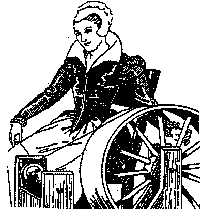
Women wore caps of various kinds. The "Mary Stuart" style, with a heart-shaped outline around the face, is still worn. Wearing the hair brushed up over pads to make a kind of beehive is a trendy aristocratic style -- a more modest version of the same is also worn. Close curls are still worn also, with the long hair gathered into a bun in the back that was usually covered with a small cap or net of some kind. Women also wear menís style hats over their caps -- a scandalous fashion development according to some. A woman rarely has her hair completely uncovered, and an older or widowed woman would be likely to be even more covered. A working woman would probably have a kerchief or headcloth. A common style is to braid the hair and wrap it circularly around the back, then cover the braids with a small cap or cloth that might be woven into the braids.
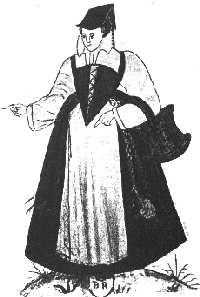 A woman wore
knee-high stockings under her skirts, held up with simple garters. She
might also wear knee-length drawers for comfort and warmth (these are crotchless,
for convenience). The custom of wearing drawers seems to originate from
Italy and was not necessarily widespread elsewhere.
A woman wore
knee-high stockings under her skirts, held up with simple garters. She
might also wear knee-length drawers for comfort and warmth (these are crotchless,
for convenience). The custom of wearing drawers seems to originate from
Italy and was not necessarily widespread elsewhere.
A gentlewoman traveling out of doors commonly wore a mask -- a full-face number, often made of black velvet, to protect her delicate complexion from the elements. She would also wear a traveling cloak.
A working woman wore an apron. This might be nothing more than a piece
of cloth tucked into the waistband of her skirt -- maybe with the upper
piece of it pinned to her bodice. Like her brothers, a working womanís
wardrobe was not much subject to change.
1.) an English gentlewoman in a French style gown, 1593. The French hood she is wearing is out of fashion in France, and is more commonly replaced with a simple cap set at the back. This picture is from Norris, not generally a reliable source, but was used in the original handout from which these materials were developed because they were black-and-white, highly compressable images from a non-copyright source. They should always be questioned and other contemporary documentary sources should be used to validate the details of any costume. They are used here merely to give an idea of the general silhouette.
2.) an English country girl, with her skirt tucked up to show the underskirt (often of nicer material). She is wearing a typical cap with the edges turned back. Norris.
3.) an English gentlewoman in a French-style gown, 1596. She is wearing the popular hairstyle of the period, with heart-shaped rolls in front that are formed by brushing the hair back over pads. Wearing the hair high in front reached such an extreme in some noble circles it looks like a beehive. Both gentlewomen are obviously wearing bumrolls under their gowns, to pad out the hips. Their bodices fasten up the back. Norris.
4.) an English market woman. Her bodice is clearly unboned and laced up the front -- typical of lower class women. Norris.
5.) a spinster. She is wearing a style that is very characteristic of the end of the century -- the open collar. Her bodice fastens with hooks and eyes and has the V-waist, which makes her particularly stylish for her class. She is wearing a very typical cap for the time. Sometimes these caps were made in very sheer linen, wired at the edges to keep their shape. They are gathered at the back, where the hair is braided and rolled into a bun, usually. Norris.
6.) a French peasant. She has
wide sleeves and a partlet with a fairly high, wide collar. Her bodice
laces down the front, but has the pointy waist and is therefore probably
boned. The position of the apron indicates that It is put on over the petticoat.
There is a generous bumroll underneath. She wears a cap very similar
in shape to the one in the picture above, although of dark color and therefore
hard to see. On top of this she has pinned a very typical French headdress
-- a simple piece of rectangular cloth, folded in half and wired on the
edges to keep its square shape. Camille Piton, "Le Costume Civil en France",
print in the BNF.